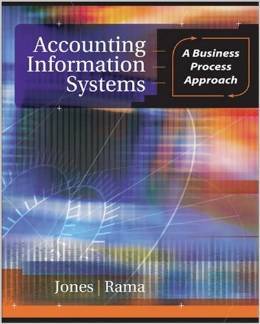Instant download Instructor Manual For Accounting Information Systems: A Business Process Approach Edition: 2nd by Frederick Jones (Author), Dasaratha Rama (Author) pdf docx epub after payment.

Chapter 1
Introduction to Accounting Information Systems
REVIEW QUESTIONS
1.
An accounting information system (AIS) is a subsystem of an MIS that provides accounting and financial information as well as other information, obtained in the routine processing of accounting transactions. Examples of information tracked by an AIS are wide-ranging, including information about sales orders, sales in units and dollars, cash collections, purchase orders, goods received, payments, wages, and hours worked.
A management information system (MIS) is a system that captures data about an organization, stores and maintains the data and provides meaningful information for management. A MIS includes other information related to production, human resources, and marketing that is not part of the AIS.
2.
Accounting information is used to
• Prepare external reports.
• Handle routine activities of the business.
• Help managers make non-routine decisions.
• Help in planning and control.
• Maintain internal control.
3.
Applications are computer programs that are used to serve particular purposes. Word-processing and electronic spreadsheet software are examples of applications. Accounting applications provide the information needed for the five uses described in response to the previous question.
4.
Off-the-shelf software is commercial software that is ready-made and available for sale to the general public. An important advantage of using off-the-shelf packages is that the amount of time and effort required to develop an accounting system is low to the consumer. However, off-the-shelf packages are not tailored to any one organization’s needs and may not satisfy all the requirements of the organization. Some vendors of accounting software reduce this problem by allow third-party developers, known as value-added-resellers, to modify the software to meet specific customer needs.
5.
Answers will vary by student.
6.
Accountants are evaluators of accounting systems in the following roles:
Internal auditors evaluate various units within an organization to do determine whether those units are efficiently and effectively pursuing their missions.
External Auditors. Corporations pay certified public accountants to audit their financial statements to meet legal requirements and to add credibility to their financial statements.
Other Evaluative Roles. Accountants are expanding their role as evaluators by providing a variety of assurance services. For example, an accounting firm may provide assurances to a lender, that the company has not violated any part of a complex loan agreement. Recently, the American Institute for Certified Public Accountants (AICPA) has promoted a service to be provided by its members, WebTrust, that increases the confidence of customers who are considering engaging in a transaction on the internet. As another example, some audit firms are providing services such as performance evaluation and risk analysis.
7.
Production information that may have no direct bearing on accounting balances include maintenance schedules, engineering designs, and specification of components required for manufacturing different products. Areas of overlap included parts inventory information such as re-order points, quantity-on-hand and quantity committed to work-in-process, and the amount of labor and materials used in production. Since most of this information would be collected at the manufacturing facility, the production department would be responsible for recording orders and receipts of inventory, as well as usage of materials and labor. The accounting department may be responsible for maintaining information about employees for payroll tax purposes, and certain inventory information such as inventory costing method. It may also be responsible using the material and labor usage information to track costs and paying for the ordered items once received.
8.
Human resources information that would have no direct bearing on accounting balances include sick days allowed and taken, vacation days allowed and taken, insurance and retirement beneficiaries, accidents and injuries on the job, insurance selection, job-title changes, results of drug testing, personnel actions and schedules for interviewing and training. Areas of overlap include pay rate, regular hours, over-time hours, amounts to be withheld for various purposes such as insurance, income taxes, retirement and union dues. The areas of direct overlap involve payroll and may be collected and recorded by the accounting department. Of course, information recorded by human resources is used in the accounting function for various calculations. For example, human resources may provide the information to accrue vacation pay and the amount of withholdings for insurance and retirement.
9.
As routine transaction processing becomes automated, accountants are spending less time on routine functions thus reducing the need for clerical support. Instead, they are leveraging their understanding of business processes and data organization for strategic decision making and planning. In addition, accountants are broadening the services that they perform. The 2004-2005 edition of Occupational Outlook Handbook, an important reference in nearly every public library, states that “Beyond the fundamental tasks of the occupation—preparing, analyzing, and verifying financial documents in order to provide information to clients—many accountants now are required to possess a wide range of knowledge and skills. Accountants and auditors are broadening the services they offer to include budget analysis, financial and investment planning, information technology consulting, and limited legal services.”
10.
Routine activities:
• Record sales and cash collections.
• Record purchases and payments to suppliers.
Decision Support:
• Identify new products that the company should sell in the future.
• Identify most profitable products.
Planning and control:
• Prepare sales budget for next year.
11.
The answer will vary by student.
12.
The answer will vary by student.
13.
Users may want reports that show information that satisfies a certain criteria (a product whose sales increased by more than a certain percent compared to prior date). Sales could be listed in descending order of changes (e.g. list products whose sales grew the most compared to prior date first). The report could group products into categories. Finally, a summary report that summarizes changes by categories rather than by individual products may be useful.
14.
The answer will vary by student.
COMPREHENSIVE CASE
See solution to entire case in separate file.





